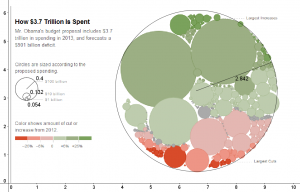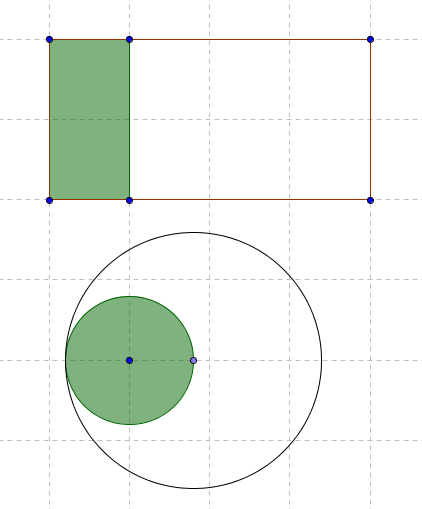Circle graphs are the worst
Flashy animations are all the rage on cable news networks. And people love infographics. Both show a illogical love for graphs made out of circles.
From the NYtimes.com : http://www.nytimes.com/interactive/2012/02/13/us/politics/2013-budget-proposal-graphic.html?hp

radii measured with geogebra after constructing a circle through three points plotted on the edges of the graphics circles.
There are two issues: squared ratios, and packing.
The first arises that as you change the radius of the circle, the area will increase by the square of the radius. So the designer has to choose one measurement to represent their unit. It appears that they chose area for this graph. The given scale seems accurate for the $100 billion circle’s area to the $10 billion circle’s area. However, the $1 billion circle appears to be off, or I can’t measure it precisely enough. The problem here is that we are better at recognizing linear relationships rather than square relationships.
The problem here is human intuition. Does the largest circle look like 10 times as large as the medium one?
Consider these two representations of an area growing by a factor of 4. Which is more natural?
To the unpracticed geometer, it may seem very difficult to believe four green circles fit into the large one. Large area-scaled circles “seem smaller” than they should
That is the second issue: packing. Rectangles are easy to pack. Copy that green rectangle 3 more times and it will fit exactly in the area outlined. But to fit the circle into its large circle of 4x the area, it requires distortions. Those distortions harm the communication of knowledge. Back in the first image, they attempt to pack a lot of various budget area’d circles in a large circle. But the empty space makes the budget cover an area much larger than it should.
Infographics should always aim to present data in a way that makes it easier for the public to understand. When style is chosen over substance, the information is distorted, literally. Because of the competing effects of being too large or too small, I don’t believe the mis-communication was malicious. Rather, it was ignorant.




